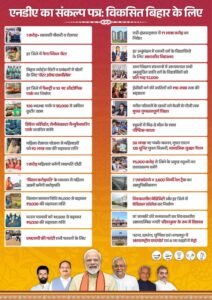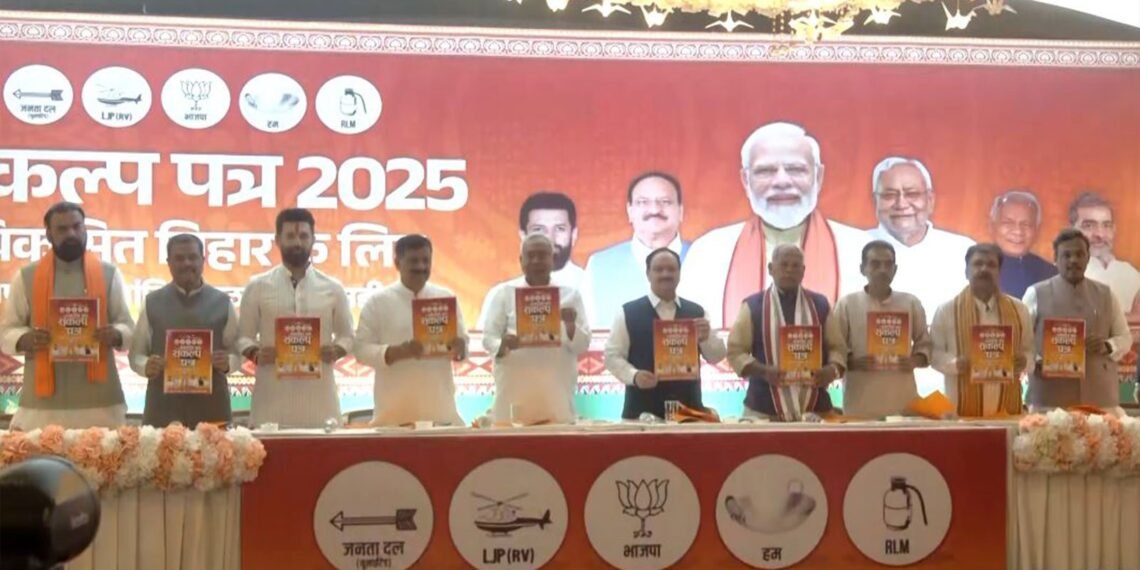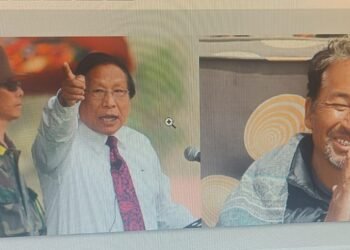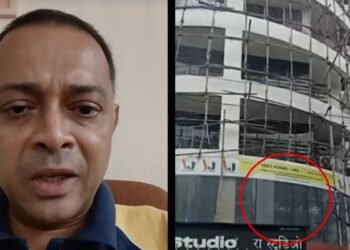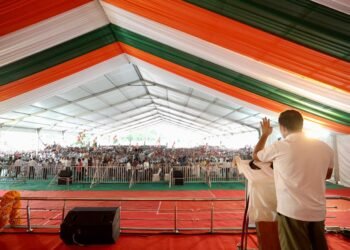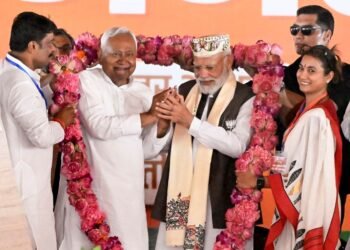From ‘Lakhpati Didis’ to industrial parks in every district, the Sankalp Patra brims with ambitious pledges that could reshape Bihar’s economy — if they materialise.
BY Navin Upadhyay
October 31, 2025 – In a blaze of optimism and alliance pomp, the National Democratic Alliance (NDA) unveiled its election manifesto, Sankalp Patra 2025, at a high-profile event in Patna today. Attended by Bihar Chief Minister Nitish Kumar, BJP president JP Nadda, and other heavyweights like Chirag Paswan and Jitan Ram Manjhi, the 69-page document paints a utopian vision of Bihar as a hub of jobs, industries, and empowered women. But as the cheers faded, a glaring question lingered: where exactly will the resources come from to fund this celestial wishlist? Critics are already calling it a “moonshot without a rocket” — grand promises amid Bihar’s stark realities of floods, stagnation, and unfulfilled vows.
The manifesto’s headline-grabbers are nothing short of audacious. The NDA pledges one crore government jobs for the state’s youth, alongside a “skills census” and mega skill centers in every district to turn Bihar into a “global skill training hub.” It vows to make one crore women “Lakhpati Didis,” offering financial aid of up to ₹2 lakh under the Mukhyamantri Mahila Rojgar Yojana to foster self-reliance and prosperity. There’s even a “Mission Crorepati” to elevate select women to millionaire status through entrepreneurial support.
On the industrial front, the alliance promises manufacturing units in every district, ten new industrial parks, defence corridors, a semiconductor park, and a whopping ₹50 lakh crore in investments over five years under the “Viksit Bihar Industrial Mission.” Add to that seven expressways, metro services in four more cities, seven international airports, free education from KG to PG, and ₹3,000 annual aid to farmers via the Karpoori Thakur Kishan Samman Nidhi — it’s a laundry list that could make even the most jaded voter raise an eyebrow.
Union Minister-BJP chief JP Nadda, CM Nitish Kumar, Union Minister-HAM(S) Custodian Jitan Ram Manjhi, Union Minister-LJP(RV) Chief Chirag Paswan, RLM chief Upendra Kushwaha and others release NDA’s ‘Sankalp Patra’ in Patna.#BiharElection2025 pic.twitter.com/BfOdtUFvAc
— Inquisitive S (@InquisitiveS_) October 31, 2025
Yet, buried in the fine print — or rather, conspicuously absent — is any concrete roadmap for funding these ambitions. Bihar’s economy, heavily reliant on agriculture and remittances, grapples with a fiscal deficit hovering around 3–4% of GSDP, with public debt exceeding ₹3 lakh crore as of 2024–25. The manifesto mentions attracting private investments but offers no tax incentives, policy reforms, or revenue projections to back it up. “It’s all sizzle, no steak,” quipped a Patna-based economist. “Where will the ₹50 lakh crore come from? Central transfers? Loans? Magic?” The NDA’s “double-engine growth” slogan — touted as coordinated Centre–state synergy — rings hollow when Bihar’s share of central capital expenditure has stagnated at under 5% of the national pie in recent budgets.
READ: Epstein Link: Prince Andrew Cast Out: No Titles, No Palace, No Return
READ:Opinion: Trump’s Power Play and the New American Disorder
The promises hit especially hard in Bihar’s flood-ravaged north, where annual monsoons maroon nearly half the state for up to six months, displacing millions and wrecking livelihoods. Districts like Kosi and Bagmati see entire villages underwater, with crop losses exceeding ₹10,000 crore yearly. The manifesto nods to infrastructure like expressways and rail modernisation but is mum on flood mitigation — no mention of embankments, resilient irrigation, or climate-adaptive farming. How, then, will industries sprout in these waterlogged wastelands? “We’re talking semiconductors in Supaul? Good luck with that when the river decides to relocate your factory every July,” scoffed a farmer from Madhubani, one of Bihar’s most flood-prone areas.
The women’s empowerment pledges, while laudable on paper, fare no better under scrutiny. Turning one crore women into “Lakhpatis” (earning ₹1 lakh annually) or even “Crorepatis” in a state where female workforce participation languishes at 20% — the lowest in India — sounds aspirational. But Bihar’s industrial base is skeletal: just 1.2% of the state’s GDP comes from manufacturing, according to 2023–24 economic data, with few formal industries beyond Patna and a handful of agro units. Over the last two decades of NDA rule — intermittently with Nitish Kumar at the helm since 2005 — industrialisation has been a non-starter. Promises of “one district, one factory” in 2016 fizzled out, with only sporadic investments in textiles and food processing. Now, post-2020 NDA resurgence, voters are told every one of Bihar’s 38 districts will host buzzing factories. Without roads, reliable power (outages persist in rural areas), or skilled labour pipelines, this feels like retrofitting a dream onto a drought.
The one-crore-jobs vow is the manifesto’s crown jewel — and its biggest punchline. Bihar’s youth bulge (over 50% under 25) desperately needs employment, with unemployment at 7.6% and underemployment rampant. But creating 10 million jobs in five years would require adding 2 million annually, dwarfing the state’s current formal sector growth of under 1%. The NDA cites skill centers and global placements, but past efforts tell a different story: the 2017 Bihar Skill Development Mission trained thousands, yet placement rates hovered below 30%. “One crore jobs? In Bihar, where migration drains 40 lakh youth yearly to other states? This isn’t a plan; it’s a prayer,” said a labour economist from IIT Patna.
Block could make by projecting Mukesh sahini as deputy cheif minsiter. The sankpal aptra especially mention the sub-castes like Bindi, Gangota, Makllah, kewat etc which Sahini erpresents and offers incistives to them.
The NDA’s Sankalp Patra 2025 appears carefully crafted to neutralise the INDIA bloc’s growing appeal among Bihar’s extremely backward castes (EBCs), particularly the Nishad and allied communities represented by Mukesh Sahani. Sahani, projected by the opposition as their prospective deputy chief minister, has been attempting to consolidate the votes of sub-castes such as Bindi, Gangota, Mallah, and Kewat—groups with a strong presence in north and central Bihar. In response, the NDA manifesto makes an explicit outreach to these sub-castes, highlighting their contribution to Bihar’s development and promising targeted welfare benefits and social empowerment schemes.
The manifesto not only acknowledges these communities by name but also proposes tailored incentives such as expanded fishing cooperatives, modernised river-based industries, and special credit lines for small boat operators and traders from the Nishad sub-castes. This deliberate inclusion signals the NDA’s intent to erode Sahani’s narrative of exclusion and reclaim its EBC base that has shown signs of drifting toward the INDIA bloc. By embedding caste-specific promises within the broader framework of economic empowerment and employment generation, the NDA seeks to project inclusivity while undercutting the opposition’s caste arithmetic.
As the Mahagathbandhan’s Tejashwi Pran manifesto — released earlier this week with its own job-per-family pledge — looms large, the NDA’s document comes off as reactive bravado. Deputy Chief Minister Samrat Choudhary called it a “guarantee of the five Pandavas,” nodding to the alliance’s unity, but voters in flood-hit villages and jobless towns may see it differently — as a familiar script of tall tales from an alliance that has held power for most of the last 20 years.
With polls set for November 6 and 11, Bihar’s 7.3 crore electorate will decide if these promises are a launchpad to the stars or just another election-season fireworks display. For now, the moon looks close — but the bill remains unpaid.
